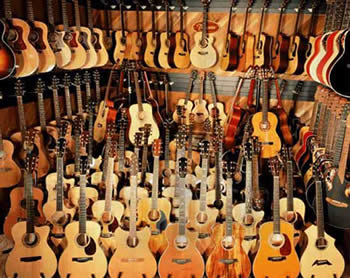by Kathy Unruh

The steel-stringed acoustic guitar is usually credited with being developed by C.F. Martin and Company sometime during the 1830s. Although other “gut-stringed” acoustics were around at that time, it was the Martin Company that introduced the idea of cross-bracing underneath the soundboard which enabled the guitar to support the heavier steel strings.
Because there is approximately 160 lbs. of tension created by the use of steel strings, they should never be put on a classic guitar, for it is not strong enough to carry them. But thanks in part to C.F. Martin’s new design, the use of steel strings on the acoustic guitar became fairly common by the end of the 1800s, and by the 1930s it became a standardized component.
The acoustic steel-stringed guitar is commonly referred to as a “dreadnaught”, possibly after a British battleship by that name, which was the first of it’s type to use heavy armor and large-caliber guns in turrets.
The addition of steel-strings to the acoustic guitar produced a brighter sound and created more versatility than was possible with the previous gut-stringed instruments. A wide range of tone and color can be achieved on the steel-stringed acoustic guitar which can either be strummed or picked with the fingers. This makes it one of the most popular choices among guitarists of such diverse styles as blues, jazz, fingerstlye, bluesgrass, folk, rock and more.
When creating such a guitar, a luthier’s (someone who builds guitars) primary objective will be to achieve a rich quality of sound. The types of wood used will have a great effect on the tone and volume of the instrument, as well as it’s overall appearance and aesthetic value. Traditionally spruce (or sometimes western red cedar) are used for the face of the guitar. Mahagony is used for the neck, and ebony or rosewood for the fretboard. Rosewood, mahagony or maple, have historically been the woods most commonly used for the back and sides. There are some variations, of course, but most factory-made acoustic guitars use the same recipe.
During the 1960s, the Kaman Company broke with tradition by introducing The Ovation; an inovative acoustic guitar designed with a round back that is made of synthetic materials instead of wood. All Ovation guitars feature an adjustable steel tension rod in the neck. The tension rod serves two purposes. First of all, it counterbalances string tension, giving the neck addiional strengh. Secondly, it permits adjustment of the neck should changes in humidity, string tension, or string guage cause the neck to warp or bow. I personally own an Ovation Legend Elite 12-string acoustic-electric. The guitar is beautiful in appearance and features 22 sound holes which are enclosed by a leaf design made of walnut and padauk. It has a wonderful sound either acoustically or amplified and is extremely easy to play. My own belief is that Kaman/Ovation makes one of the finest 12-string acoustic guitars money can buy.
Now if you’re looking for a 6-stringed acoustic guitar that will bring you years of playing enjoyment, you might want to consider a Martin. There are several models to choose from, so you’re bound to find a quality instrument at a price you can afford. On the other hand, if you are looking for a durable and beautiful 12-stringed acoustic guitar, then Ovation might be the way to go. You can rest assured that, either way, these companies stand behind their products 100% in order to guarantee your satisfaction and peace of mind. And that is worth a whole lot in my book.